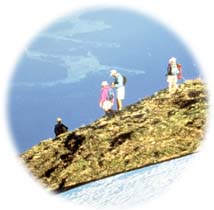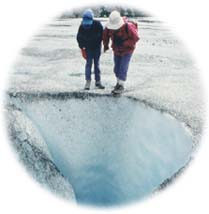|
Inspired by the US and Canadian National Parks concept, BC's first provincial park, Strathcona, was created on Vancouver Island in 1911. This was followed by Garibaldi, adjacent to the city of Vancouver, in the early 1920s. From then on the idea of expanding the parks system had a certain prestige about it, and several large parks were created by the BC government such as Wells Gray,  Tweedsmuir, and Manning in the 1930s and 1940s. The intention at this time was to retain large expanses of natural, scenic landscape. This focus came about as the logging industry was moving farther into interior BC, encroaching on many wild areas. Many of the foresters associated with the BC government still had the romance of wilderness at heart, wanted to see some areas protected, and they worked to achieve their goal. Tweedsmuir, and Manning in the 1930s and 1940s. The intention at this time was to retain large expanses of natural, scenic landscape. This focus came about as the logging industry was moving farther into interior BC, encroaching on many wild areas. Many of the foresters associated with the BC government still had the romance of wilderness at heart, wanted to see some areas protected, and they worked to achieve their goal.
During this era, these large parks had virtually no management, and fell under the jurisdiction of the BC Forest Service. It wasn't until well into the 1960s that BC actually established a Parks Branch, and the parks system was no longer managed by an agency whose primary motive was to log forests.
A dark day in BC's park history occurred in the early 1960s, when the Columbia River Treaty dams were under development. As part of this construction project, Premier WAC Bennett proposed to dam the upper regions of the Columbia River. To do this he dismantled part of the 800,000 ha (2 million acre) Hamber Park, leaving an area only 60,000 acres (25,000 ha) in size. It was this loss of parkland that motivated the subsequent New Democratic government, when it was elected in the early 1970s, to rebuild the park system. At that time they legislated a number of large new parks including Atlin, Naikoon, and several others, which were intended to make up for loss of Hamber Park. Fortunately, since that time BC has never lost another provincial park.
The US Wilderness Act coupled with the migration of US activists who moved north into Canada as a result of the Vietnam War, along with the first Earth Day, led to the beginnings of the Canadian wilderness movement, especially in BC. This early movement focused on protecting areas like Pacific Rim, and the Skagit Valley.
Over the years the wilderness movement in BC expanded. Originally it had focused on protecting areas of spectacular landscapes such as the Purcells and beautiful regions which were wonderful for recreation. But increasingly there was a recognition of the importance of setting aside large, wild, untouched places, like Spatsizi, for wildlife and biodiversity. People began to understand that BC had to preserve large areas, to start to create the Canadian equivalent of the great wildlife reserves of Africa.
 By the 1980s, the British Columbian environmental movement to protect wild spaces evolved further. Now the concern was with the dramatic loss of the province's forests. The recognition emerged that if BC was going to hand on areas of natural integrity and wildness to future generations, rapid action was needed. In effect, in the 1980s British Columbia started to recognize the need to create a comprehensive wilderness system, in the way that the United States had in the 1960s. By the 1980s, the British Columbian environmental movement to protect wild spaces evolved further. Now the concern was with the dramatic loss of the province's forests. The recognition emerged that if BC was going to hand on areas of natural integrity and wildness to future generations, rapid action was needed. In effect, in the 1980s British Columbia started to recognize the need to create a comprehensive wilderness system, in the way that the United States had in the 1960s.
Also in the early '80s, the American campaign to preserve the wilderness of Alaska culminated, and the Alaska National Interest Lands Conservation Act was passed (ANILCA). In 1980, 40 million ha (100 million acres), 37% of Alaska, were protected as a result of this bill. This had a tremendous effect on campaigners in BC who realised that they had to move much more quickly. The flagship campaigns of South Moresby, and later Clayoquot Sound, focused on the rainforest, and moved this issue of protecting the great forests of BC to national awareness.
Late in the 1980s, BC conservationists began to address the fact that mining too was an industry which could threaten wilderness. The campaign to save the world class wilderness of Tatshenshini in far northern BC focussed on a proposed mega mine, whose potential to generate vast amounts of deadly poisonous acid mine drainage for thousands of years endangered North America's Wildest River.
|
By the 1990s British Columbia conservationists became even more focussed on the need to be working on not just individual areas, but on completing a system of preservation as rapidly as possible. The issue was first emphasized by United Nation's 1987 report "Our Common Future", known as the Bruntland Report. The report focused on the need for sustainable development, but also recognized that the world's diversity of species was at stake. Species were going extinct at such a rapidly increasing rate that the whole fabric of life was at risk. In response, recommendations started to emanate from the United Nations to move as quickly as possible to protect biodiversity.
This awareness led to the establishment of the International Biodiversity Treaty in the early 1990s. Concurrently, World Wildlife Fund Canada established their Endangered Spaces Program to achieve at least 12% of the Canadian wilderness by the year 2000 before it would all disappear. In British Columbia issues like Tatshenshini took the wilderness campaign beyond Canada to the White House of the United States. Eventually Tatshenshini was not only protected by the BC Government, but also designated a United Nations World Heritage Site. As well, the campaign to preserve the old growth forests attracted the attention of Greenpeace International with the result that the plight of BC's forests and wilderness gained global attention.
The British Columbia government responded to the calls in the international community and proposed in the early 1990s that BC should move rapidly to reach the United Nations' 12% protected goal by the year 2000 and by 1993 the Government had developed the British Columbia Protected Areas Strategy. The ensuing years were a time of great activity and intensity as the environmental community deepened its membership and worked on conserving a whole range of protected areas in the province. This was accompanied by strong opposition from the logging industry and to a less extent the mining industry. But in the end, the 12% wilderness preservation target was met by the year 2000, and still BC's system of protected areas continues to grow.
But the opportunity to complete it is fast disappearing as the level of development has come to such an extent that now in British Columbia over 60% of the landbase is either developed or allocated for resource development. In the south of the province 80% of the landbase is or will be developed. As a result, there are only a few years remaining in which to complete the system, and this is why conservationists urgently need the public's help.
In summary, the efforts of British Columbians to save the wild earth over the past half century are both historic and heroic. And too great achievements have been made. This citizen effort started with the campaign to protect Nitinat Triangle in Pacific Rim in 1971. This campaigning energy then extended to interior BC in the effort to protect the Purcell Wilderness in 1974. South Moresby became the first BC wilderness issue to attract national attention in 1986. Later, the campaign to protect Tatshenshini in 1993 became the first one ever to take on mining, and galvanize a continental transboundary force to lobby the governments both in Canada and the United States. Finally the effort to protect the wilderness of Clayoquot Sound (1993-94) brought the issue of wilderness protection to the awareness of the world, with the result that by the turn of the century over 12% of BC's wilderness was formally protected.
|

